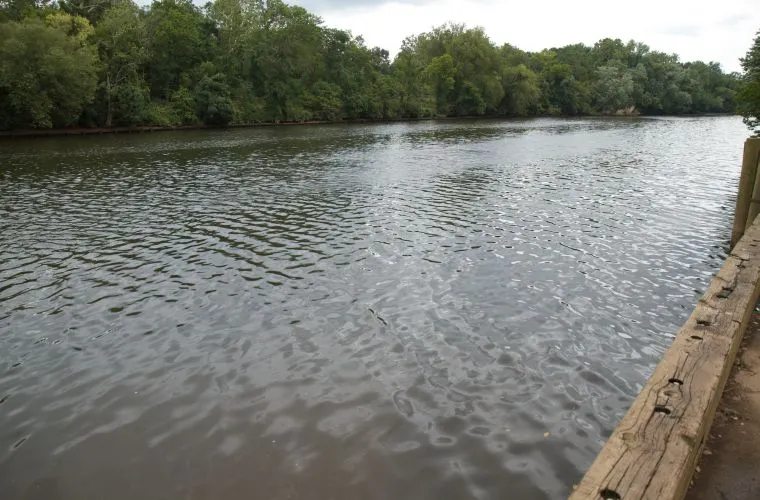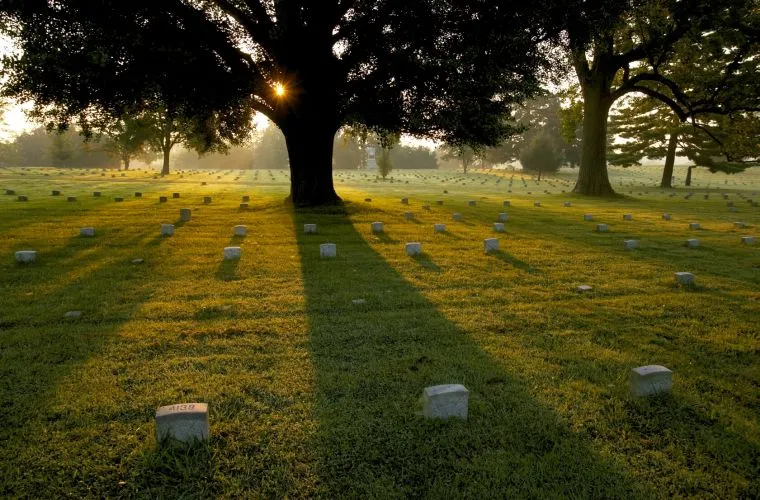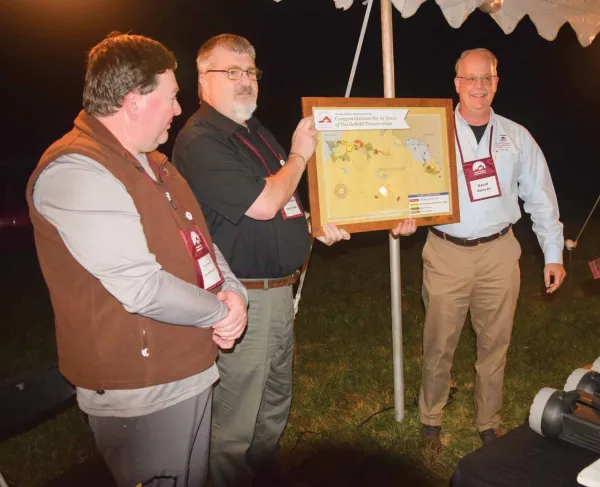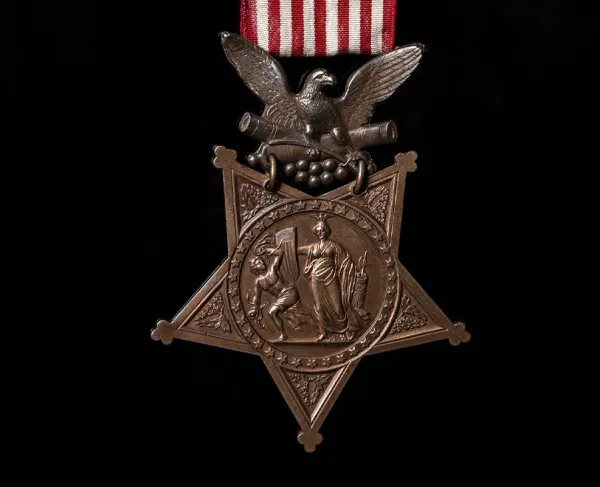
By Chris Mackowski and Kristopher D. White
Nothing — from the campaign’s earliest days back in November, to this morning’s attempt to finally bridge the Rappahannock River in Fredericksburg — had gone as planned for the Army of the Potomac. It was mid-afternoon, December 11, 1862. No bridges yet spanned the river. No Federals yet occupied the southern bank. No advance had taken place.
Instead, six boatloads of Michiganders were making their way to the far shore under intense Confederate rifle fire. Shots plucked them from their boats even as they endeavored to return fire. Others joined the engineers rowing, trying to speed the crossing.

Suddenly, the firing slackened. The steeply sloped riverbank offered the Federals cover once the Confederates posted in the homes along the crest of the bank could no longer see them. Given this unexpected reprieve by the topography, the Federals touched the south bank and leapt from their boats. “The orders were to give no quarter,” one soldier wrote.
They had no way of knowing it, but they had just made history: the first U.S. soldiers to successfully complete a large-scale, boat-borne river crossing under fire. Once more, in the midst of this campaign of urgent improvisation, the Army of the Potomac had rewritten the rules of warfare — and as the Federals scurried up the muddy banks toward battle, they were about to rewrite the rules yet again.
The tangled mess on the banks of the Rappahannock that afternoon had its origin in Maryland earlier that autumn. Frustrated with the glacial pace of Maj. Gen. George B. McClellan in the wake of the Battle of Antietam, President Abraham Lincoln replaced his popular army commander with the affable Maj. Gen. Ambrose E. Burnside. “Burnside is a pure man and a man of integrity of purpose,” the surprisingly gracious McClellan said, “and such a man can’t go far astray.”

An 1847 graduate of the U.S. Military Academy at West Point and a veteran of the old army, Burnside had headed a brigade at First Manassas and led aggressive amphibious operations against the North Carolina Coast—exploits that had won him wide acclaim.
But Burnside, who took the job so it wouldn’t go to his political rival, Maj. Gen. Joseph Hooker, wasn’t nearly as confident in his own abilities. “I am not fit for it,” Burnside told General-in-Chief Maj. Gen. Henry “Old Brains” Halleck. “There are many more in the army better fitted than I am; but if you and the President insist, I will take it and do the best I can.”
Burnside took command knowing McClellan had lost the job for not moving, so he realized he had to show action. He knew, too, that he had to do so quickly, before the full onset of winter. Most important, he had to move because the political climate demanded it: following the Battle of Antietam, Lincoln had issued the preliminary Emancipation Proclamation, which freed slaves in areas of rebellion. To give teeth to the Proclamation and give freedom to those enslaved people, Lincoln needed his armies to conquer those rebellious regions. Burnside’s reputation suggested him as a general capable of delivering the victories Lincoln needed.
Burnside looked to shift his army from the area around Warrenton, Va., toward Fredericksburg. There, he could utilize a pair of roads to move his army southward toward the Confederate capital, while using the Richmond, Fredericksburg, & Potomac Railroad to keep the army supplied. The movement would draw Lee south, where Burnside could then lure him into battle. He never intended to fight in Fredericksburg.
Speed was the key. Burnside started his army forward on November 15, but rain showers and muddy roads immediately marred the march. Still, Burnside’s men traversed the 40 or so miles in just two days. “On! on! on! we went rapidly and without a single rest!” wrote a Pennsylvania private. “Sometimes we almost stopped, and we began to hope that we would ease our aching shoulders of their burdens, but soon we had to compensate for our slowness by going almost on a run! Never were we used so hard before!”
On November 17, Burnside’s army—123,000 men—reached Falmouth on the north bank of the Rappahannock. Fewer than 1,000 Confederates held Fredericksburg on the opposite shore. Burnside knew that the three bridges spanning the river had been destroyed prior to the Union occupation the previous spring, so he ordered ahead for materials to construct a pontoon bridge. Halleck promised Burnside that bridges would be waiting for him.
They weren’t. For 10 days, Burnside waited while administrative errors were untangled enough to get the bridges to him. In the meantime, his element of surprise was swept down the Rappahannock.
Initially surprised by Burnside’s movement, Confederate Gen. Robert E. Lee looked to set up a defensive position south of the North Anna River, 25 miles south of Fredericksburg. Once Lee realized the bridgeless Burnside was stalled north of the Rappahannock, though, he dispatched Lt. Gen. James Longstreet’s 40,000-man First Corps from Culpeper to Fredericksburg, where they took up position behind Marye’s Heights to the west of town.
“A grand exodus is going on,” a Confederate of the First Corps noted as he approached the city. “All day long we met people, old and young, leaving the city, carrying their household goods with them. Carts and wagons containing their bedding, etc., going to the rear. Children and women all in the procession.”
Weeks passed. Federal engineers scouted the river, as Burnside cast about for a new plan. Although numerous fords offered possible crossing points, the Federal commander worried that if he forded the river and rain and snows swept across the valley, a portion of the army could be trapped on the southern side of the river and destroyed.
Finally, he decided to attack at Fredericksburg. “I think now that the enemy will be more surprised by a crossing in our immediate front than any other part of the river,” he said, trying to justify the choice he saw as being the best of a bad bunch.
He would cross the river at three points — sites known today as the Upper, Middle, and Lower Crossings. The Upper was at the north end of the city, the middle at the south end of the city, and the Lower about one mile south of the city at a turn in the river known creatively as “The Bend.”

On December 11 at 2:00 a.m., with the mercury hovering at 24 degrees and a heavy fog rising from the Rappahannock to fill the river valley, Burnside set his plan into motion. The 50th New York Engineers moved pontoon trains to the river, which was lined with a thin layer of late autumn ice. For three hours, the men worked to extend the bridge from north bank to south, their work shrouded by darkness and muffled by fog.
Nonetheless, their labors did not go undetected. Confederate Brig. Gen. William Barksdale, charged with defense of the city itself, waited until the bridges stretched past the halfway point, making sure the Federals were fully committed to their project, and then sent the signal for his Confederates to mobilize. At 5:00 a.m., a pair of cannon blasts from the crest of Marye’s Heights split the pre-dawn stillness.
Barksdale’s 1,600 men — Mississippians bolstered by Floridians — scrambled into action, taking up positions in the homes and warehouses along the river’s south bank. “I was standing at the extreme outer end of the bridge encouraging my men, when happening to cast my eyes to the shore beyond just as the fog lifted a little, I saw what for the moment almost chilled my blood,” recalled Capt. Wesley Brainerd of the 50th New York Engineers. “A long line of arms moving rapidly up and down was all I saw, for a moment later they were again obscured by the fog. But I knew too well that line of arms was ramming cartridges and that the crisis was near.”
The engineers sped up their work in anticipation of the firestorm about to erupt. Ten tense minutes later, the storm broke.
“The bullets of the enemy rained upon my bridge,” Brainerd said. “They went whizzing and zipping by and around me, pattering on the bridge, splashing into the water and thugging through the boats.”
Confederate fire drove the Federals from the Upper and Middle Crossings. Once the engineers retreated, the Confederate fire ceased. Out again crept the engineers to resume work. Once they did, the Confederates resumed fire. The deadly cat-and-mouse went on throughout the morning.
To break the impasse, Burnside tried something new: he sought to dislodge the Confederate marksmen by bombarding the city. With 147 artillery pieces on the heights along the river’s north bank — a number that eventually rose to 183 — he opened fire. “When the artillery fairly opened the roar was terrific — dreadful — I know of no words to express it,” said surgeon Clark Baum of the 50th New York Engineers. “The screeching of the shells thru the air the whiz of the solid shot, the boom, boom, boom of the cannon, the sharp ring of the rifles and rattle of the musketry all commingled made one’s ears tingle.”
Never before had the U.S. Army bombarded an American city. In an attempt to drive out the Confederates, more than 8,000 rounds were fired into Fredericksburg. The 57th and 66th New York Infantries, lining the riverbank, added their weight by firing volley after volley into the buildings where Barksdale’s Confederates laid in wait.
“Tons of iron were hurled against this place,” a Mississippian recalled, “the deafening roar of cannon and bursting shells, falling walls and chimneys, bricks and timbers flying through the air, houses set on fire, the smoke adding to the already heavy fog, the bursting flames through the housetops, made a scene which has no parallel in history. It was appalling and indescribable, a condition which would paralyze the stoutest heart, and one from which not a man in Barksdale’s Brigade had the slightest hope of escaping.”
Yet survive they did. The 8th Florida, anchoring Barksdale’s left flank, panicked and fled under the pressure, but otherwise his men held, simply hunkering in basements and hiding behind walls until the artillery fire slackened. Then they reappeared and opened fire again on the Federal engineers.
By 2:00 p.m., the anger in the Union high command was palpable. “The army is held by the throat by a few sharpshooters!” Burnside fumed.
Brig. Gen. Henry Hunt, the Army of the Potomac’s chief of artillery, posed another novel idea. Since the army had both infantry and pontoon boats, why not put the infantry in the boats and ferry the soldiers across the river and secure the far bridgehead by force?
Burnside initially loved the idea, though he balked at ordering men across in a forlorn hope. Only if men “volunteered” to go would he give approval to the plan. Col. Norman Hall told Hunt he was happy to provide the volunteers — the 157 men of his former regiment, the 7th Michigan.
The Michiganders moved to the upper crossing area around 3:00 p.m. To give them cover, Hunt’s guns opened again on the city.
Twenty to 25 men piled into each boat. The plan was for the engineers to paddle the infantry across, but as the Michiganders jumped into the boats, many of the New Yorkers leapt out. The engineers had been under fire most of the day and had had enough. Some of the infantrymen wrestled the engineers back into the boats, while others launched without them.
Six boats struck out, with four hundred yards to cross. The going was slow: the flat-nosed pontoons were built for buoyancy, not speed.
Mississippians from the shore poured fire into the boats. Union artillery wasn’t able to keep the Confederates pinned down because of faulty shells and because Union gunners couldn’t depress the barrels of their cannon low enough to hit the shore.
To speed themselves up, the Michiganders used their rifle butts to paddle. Some boats spun in circles as the men on one side paddled faster than those on the other. Other boats slowed due to mounting casualties. Near the midpoint across the river, Lt. Col. Henry Baxter, commander of the 7th, was wounded in the chest. He ordered his men to turn back — but his second in command, Maj. Thomas Hunt, ordered them to keep paddling.
“Hundreds of my comrades and I on the hilltops looked down on the brave fellows on the river, tugging and fighting with death itself,” witnessed William McCarter of the Irish Brigade. “An oarsman would be seen relinquishing his oar and falling down dead or wounded in the bottom of his boat or overboard into the river. Then another would drop while not a few of their partners with rifles in hand were suffering a similar fate by their side. I think this was sad. It may have been the saddest sight during my life in the army.”
Then came the unexpected respite offered by the topography. The Confederates, situated on the far side of Sophia Street, couldn’t shoot down over the riverbank, which shielded the final stretch of the Union crossing. Soon, the flat-nosed boats drove into and onto the shore, and Union soldiers spilled out onto the riverbank. They had successfully completed the first large-scale, boat-borne riverine crossing under fire in American military history.
Up the bank they rushed — up and over and into the homes that lined Sophia Street. “Michigan men made a rush at the nearest houses and took quite a number of prisoners,” a Federal observer noted. “The orders to the whole Brigade were to bayonet every armed man found firing from a house...but it was not of course obeyed.”
Nonetheless, said another, “It was fiendish work….”
“[I]n the space of a few minutes,” Hall later stated, “31 prisoners were captured and a secure lodgment effected.” On the far bank, meanwhile, the engineers went back to work. Within 30 minutes, the upper bridge was complete.
Confederate focus, meanwhile, shifted from the bridge-builders on the river to the Wolverines now in the city streets. To secure the lodgment, men from the 19th Massachusetts ferried across and anchored the 7th Michigan’s right flank, tucking themselves to the right front of the bridgehead. More Federals streamed across the river, including the 20th Massachusetts, the so-called Harvard Regiment.
In response, Barksdale set up a defense in depth, pulling his men from Sophia Street back to Caroline Street. When the 7th Michigan advanced after them up Hawke Street, they made it only 20 yards before the Confederates stymied them and forced them into a small alley for protection.

With the area around the bridgehead now clogging with Federals, Capt. George Macy of the 20th Massachusetts decided that they must press forward. He massed his men in a marching column along Hawke Street, then called forward to Thomas Hunt to advance his Michiganders; the 20th, he said, would move in their support. Hunt refused. “[N]o man could live around that corner,” he said.
They sent word to their division commander, Maj. Gen. Oliver O. Howard, for orders. As they awaited his reply, casualties mounted. Confederates held the “high ground”—that is, they were in the second and third floors of buildings, firing down on the Federals. “Nearly every house and cellar had someone in it, firing from the windows,” claimed one Union officer.
Finally word came back from the aloof Howard. He told his subordinates “to push ahead.” Regimental commanders fought with one another over who had to do the pushing. Hunt’s men, happily tucked in their alley, had seen enough. “Go to hell with your regiment then,” Macy told Hunt, and then, in column, the Bay State men bravely advanced.
“It was a wonderful display of orderly movement by a body of men of unsurpassed courage and coolness,” said a witness from the 19th Massachusetts as the Harvard men moved into the intersection of Hawke and Caroline Streets. “Instead of skirmishing warfare and fighting from house to house, as we advised, the advance was in mass.” Confederate fire poured into their ranks from houses on all four corners.
The first company, under Capt. Henry Abbott, rushed through the intersection while the two following companies swung north and south into battle line, sealing off the intersection and exchanging fire with muzzle flashes. “[The enemy] could not be seen except for the flash of the[ir] guns,” Lt. Henry C. Ropes later said.
The 20th Massachusetts stood its ground in the intersection as men attempted to clear buildings one by one. “Here we cleared the houses near us, but shot came from far and near — we could see no one and were simply murdered,” said Macy. “[E]very shot of the enemy took effect. How I escaped I cannot say, as…more than a dozen [men] actually fell on me.” In less than 20 minutes, one-third of the regiment were casualties.
At the south end of the city, the story was much the same. The 89th New York, similarly “voluntold” for the crossing, pushed through warehouses to clear them of Confederates while engineers finished spanning the river. Barksdale’s men soon felt the inexorable weight of Federal numbers all throughout the city. Burnside’s army continued to push outward from its bridgeheads, moving deeper into the city, house by house, street by street, block by block, forcing Barksdale back. Still, Barksdale resisted an order to fall back to the main Confederate line, waiting for nightfall to screen his withdrawal.
“Here at our feet lies the once beautiful city of Fredericksburg…” said a victorious Federal, who noted the “black pall of smoke from which at time could be seen … tongues of fire, darting upward from the exploding shells & from burning houses. Beyond the doomed city, on the opposite hills could be seen the frowning battlements of the enemy & in rear their numerous camps.”
Once the Union army finished crossing, soldiers took out their frustrations by looting and pillaging almost at will. The next day, rather than push forward with an attack, Burnside rested his troops. Not until December 13 would they traverse the open fields south of town now known as the Slaughter Pen or the open uphill slope immediately west of town toward the cannon-lined crest of Marye’s Heights. Confederate infantry tucked behind a stone wall there would deal such carnage that the Army of the Potomac would suffer its most lopsided defeat of the war—12,653 Union casualties, compared to fewer than 5,377 for the Confederates.
As a prelude to that carnage, the river crossings and subsequent street fighting resulted in nearly 600 casualties — more than 350 Union and 242 Confederate. Yet that action on December 11 proved to be decisive in the final battle: Lee had hoped Barksdale would buy him a few hours with his delaying action but, instead, the white-haired Mississippian had bought an entire day. Burnside’s delay on December 12 gave him another. The time proved invaluable. Once Burnside had tipped his hand, Lee called for the other half of his army — the Second Corps commanded by Lt. Gen. Thomas Jonathan “Stonewall” Jackson — which had been strung out over a 25-mile line to the south to block any crossing Burnside might have chosen to make in that direction. Barksdale’s work gave Jackson the time he needed to consolidate in Fredericksburg, along the south end of the line, at the exact point where Burnside planned to attack.
Had Burnside gotten across the river faster, or had he launched his attack on December 12, he would have struck across the Slaughter Pen Farm when it was the least-populated section of the Confederate position. By waiting until December 13 to attack, Burnside ended up attacking a position where an average of six Confederates defended each linear foot.
The action on December 11, 1862, certainly stands out among the many engagements of the war. Fredericksburg was the site of the first intentional bombardment of an American city by the Union army, the site of the first riverine crossing under fire in American military history, and the site of the first major urban combat in the American Civil War. Ambrose Burnside had done much to rewrite the rules of warfare on the fly as his campaign unfolded.
“Fiendish work,” indeed.

Learn More: The Battle of Fredericksburg
Chris Mackowski and Kristopher White are the co-founders of Emerging Civil War. Mackowski is an associate professor of journalism and mass communication at St. Bonaventure University, as well as a historian for Fredericksburg & Spotsylvania National Military Park. White is a historian for the Penn-Trafford Recreation Board and a continuing education instructor for the Community College of Allegheny County. He spent five years as a staff military historian at Fredericksburg & Spotsylvania Military Park, where he still volunteers his services.
Related Battles
12,500
6,000





